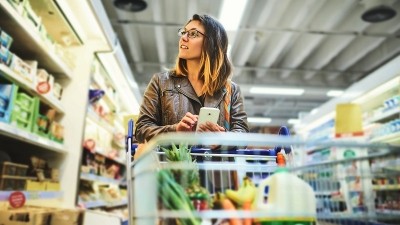Reinventing fresh: How brands, retailers can boost Gen Z, millennial engagement with social media

“It is so important for us to think and look beyond fresh [food] inspiration on how we can reinvent ourselves because that is [what] Gen Z and younger millennials are about. They love reinvention. They embrace the change. They live in the trends. ... This is not going to be one size fits all — it is one size fits none,” said Kelly Krumholz, consultant for perimeter at Circana.
Gen Z, young millennials buy less fresh than older cohorts
Fresh food brands and retailers might be failing to resonate with younger consumers, the panel of speakers explained.
Gen Z and younger millennials registered a lower percentage of dollars spent on fresh compared to other demographics at 27% and 26% of the total basket, respectively, for the 52 weeks, ending July 14. Gen Z was slightly down year over year, with a 0.2% drop from the previous year, while younger millennials stayed the same from last year.
Boomers, Gen X and older millennials purchased greater levels of fresh food which amounted to 31%, 29% and 28% of total basket, respectively. Additionally, Boomers, Gen X and older millennials increased their purchase of fresh food over the last year, growing 0.5%, 0.4% and 0.2%, respectively.
What the fresh category can learn from grape's viral social media moment
Retailers and brands can tap into younger consumers' demands for nutrient-dense foods and globally inspired flavors with the help of social media and by understanding their preferences.
"Fresh is going to change. The categories themselves are going to change. The product mixes are going to change, especially as these younger cohorts come into their own. They especially embrace lean proteins," Krumholz said. "They are really into fresh, flavorful and nutrient-dense produce — berries, apples, mandarin oranges and broccoli.”
Chicken breast, fresh berries, fresh apples and deli entrée sushi were some of the largest categories of fresh spending for younger cohorts, accounting for 4.7%, 4.2% and 1.8% of total fresh departments spend, respectively. Deli entrée sushi, packaged turkey lunchmeat and fresh mandarins were just below that, tied at 0.9% of total fresh departments spend.
Viral social media moments around grapes and sour grapes show the potential of engaging with younger consumers, Krumholz noted. The frozen grape trend — where consumers dipped frozen grapes into various candies — blew up on TikTok as a sweet snack hack while Cotton Candy grapes grew awareness through viral social media posts.
The grape category was experiencing higher prices due to inflation over the recent year, and with the boost from social media, it was able to sustain volume sales, Circana research noted. The fresh grape category saw $626 million in sales, growing 1.5% in units, for the 52 weeks, ending July 14.
Consumers turn to digital channels, TikTok becomes ‘a juggernaut’ among younger consumers
While most shopping is still done in brick-and-mortar stores, consumers use digital channels to educate themselves about a purchase, while ecommerce platforms are used more by younger consumers, the webinar panel explained. Circana estimates "70% of sales will be digitally influenced by 2027," regardless of age demographics.
“This is not just about the sales made via your phone or your tablet, but it is what you see in the world around you via your phone that influences what you purchase next, a great example of that is being driven by social media. Social media is especially important for our young consumers, where they spend a lot of their time for entertainment and information,” Krumholz elaborated.
Gen Z and younger millennials are more likely to purchase through ecommerce platforms. The two age demographics spent $12.2 billion on food and beverage through ecommerce platforms, with online purchases typically being twice as large as brick-and-mortar trips, according to Circana Receipt data for the 52 weeks, ending June 16.
More than three-quarters (76%) of consumers between the ages of 18-34 purchased products because of what they saw online, higher than the general populace at 64%, according to Circana Primary Shopper Data. TikTok has “been a juggernaut” when it comes to influencing purchases, with 47% of consumers using the platform to educate themselves on a purchase, Krumholz said.


















